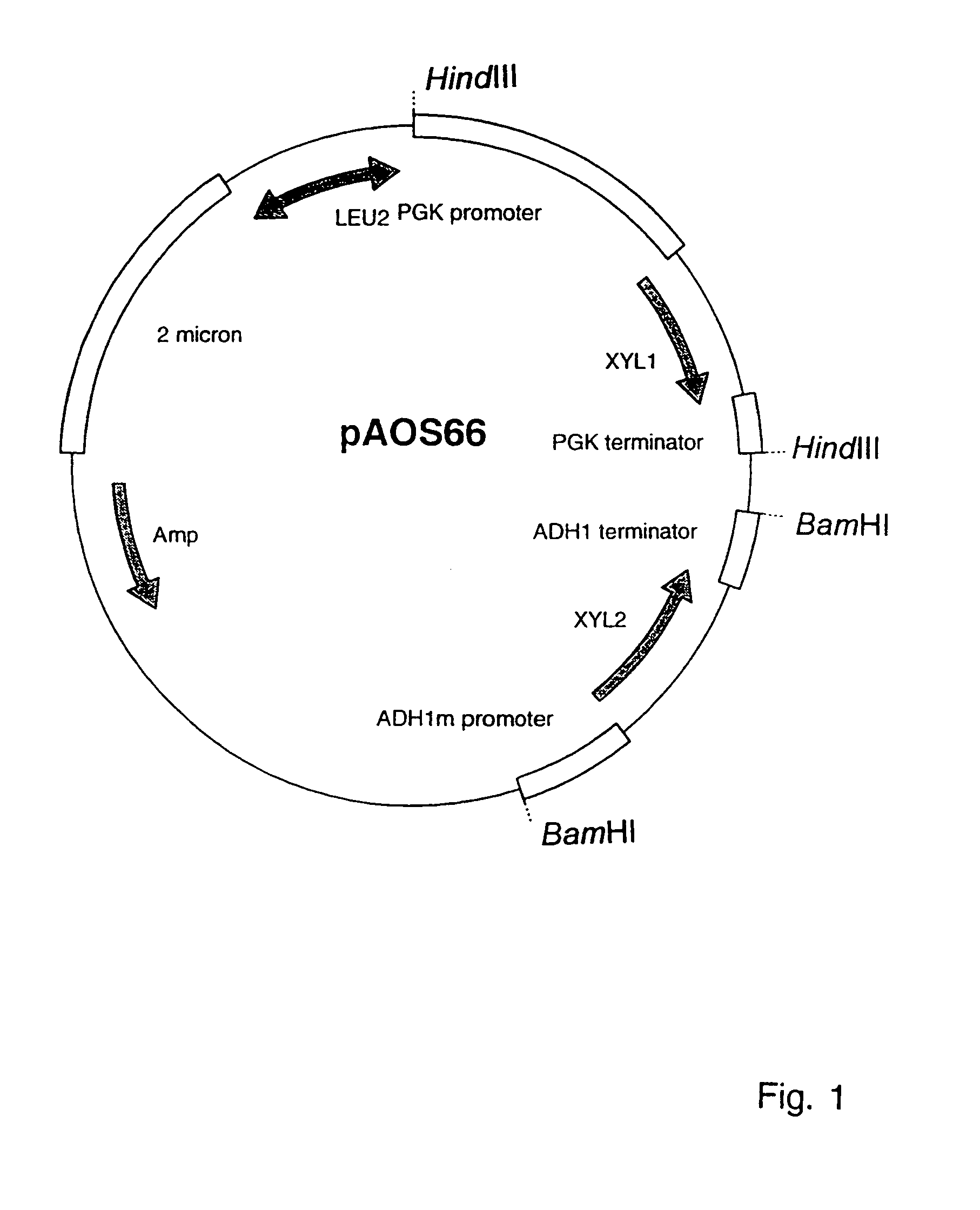Transformed microorganisms with improved properties
- Summary
- Abstract
- Description
- Claims
- Application Information
AI Technical Summary
Benefits of technology
Problems solved by technology
Method used
Image
Examples
example 1
Construction of the Integrant Strain with the XYL1 and XYL2 Genes of Pichia Stipitis Encoding Xylose Reductase and Xylitol Dehydrogenase
[0082]The pMA91 (Mellor et al. [1983]) based yeast expression vector pAOS66 (FIG. 1) containing the XYL1 under the PGK1 promoter and the XYL2 under the modified ADH1 promoter (Ruohonen et al. [1995]) was digested with HindIII to isolate the 2.8 kb expression cassette carrying the XYL1 gene between the promoter and terminator of PGK1 and with BamHI to isolate the 2.2 kb expression cassette carrying the XYL2 gene between the modified ADH1 promoter and ADH1 terminator. Plasmid B955 (Toikkanen et al. [1998]) was used to construct the integration cassette. B955 is the Bluescript SK bacterial cloning vector (Stratagene) carrying two fragments of the URA3 gene (encoding orotidine-5′-P decarboxylase, Rose et al. [1984]); base pairs 71–450 and 781–1135 from the encoding region of the gene at SacI-XbaI sites and XhoI-Asp718 sites, respectively, of the polylin...
example 2
Cloning of Saccharomyces Cerevisiae Xylulokinase Gene (SGD no. YGR 194C)
[0085]The xylulokinase gene (XK) was amplified from total DNA of wild type yeast strain by X PCR, using forward primer 5′ CCA GTG ATA TCG AGG ATG AGA TTA GTA C 3′ (SEQ ID NO:6) and reverse primer 5′ CCA GTG ATA TCT GTA CIT GTC AGG GCA T 3′ (SEQ ID NO:7). Both primers contain an EcoRV restriction site at the 5′ end. PCR reaction conditions were: 94° C. 3′ hot start; 94° C. 1′, 55° C. 1′, 72° C. 2′, 30 cycles, 72° C. 10′ final extension. The PCR product was digested with EcoRV and purified from an agarose gel. The XK fragment was ligated into the vector B609 (Bluescribe M13; Stratagene, with the modified ADH1 promoter and ADH1 terminator) which had been treated with Klenow enzyme to make blunt ends. Orientation of the fragment was checked with BglII and EcoRI enzymes. A clone with the right orientation was digested with BamHI and the fragment was purified from an agarose gel. The BamHI fragment was cloned to BamHI...
example 3
Cotransformation of the Integrant Strain H1469 with the Genes Encoding Xylulokinase (XK) and NAD-Dependent Glutamate Dehydrogenase (NAD-GDH) on Two Separate Multicopy Expression Vectors
[0086]Two yeast expression vectors, the above described YEplac195 carrying the gene encoding the xylulokinase and YEplac181 carrying the gene GDH2 encoding the NAD-dependent glutamate dehydrogenase (Boles et al. [1993]) were cotransformed into H1469 integrant strain. YEplac195 vector was selected for by omitting uracil and YEplac181 by omitting leucine from the growth medium. Plasmid rescue from the yeast transformants verified the integrity of the two expression plasmids. The strain carrying both XK and NAD-GDH encoding genes was named as H1803 (VTT C-98302). A control strain carrying the gene encoding XK and YEplac181 control plasmid without GDH2 was named as H1805 (VTT C-98303).
PUM
| Property | Measurement | Unit |
|---|---|---|
| Fraction | aaaaa | aaaaa |
| Molar density | aaaaa | aaaaa |
| Molar density | aaaaa | aaaaa |
Abstract
Description
Claims
Application Information
 Login to View More
Login to View More - R&D
- Intellectual Property
- Life Sciences
- Materials
- Tech Scout
- Unparalleled Data Quality
- Higher Quality Content
- 60% Fewer Hallucinations
Browse by: Latest US Patents, China's latest patents, Technical Efficacy Thesaurus, Application Domain, Technology Topic, Popular Technical Reports.
© 2025 PatSnap. All rights reserved.Legal|Privacy policy|Modern Slavery Act Transparency Statement|Sitemap|About US| Contact US: help@patsnap.com



